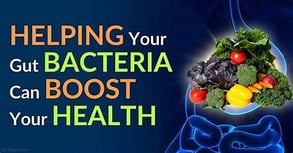Jun 10, 2020 12:19:30 PM
Eat your way to a Healthy Gut
by Kim Banting, Holistic Nutritional Consultant, BODiWORKS Institute
If asked about the cause of digestive and intestinal issues, most people would put the blame on antibiotics or perhaps, genetics or stress. And while these are all factors, one thing that is often overlooked, is the effect, your lifelong eating habits have on health, vitality and longevity!
Most of us Canadians do not eat the recommended servings of fruits and vegetables. Most people eat far more meat and protein than they need. Also consuming too much bread, pasta and pastries. Surprisingly, even people who have overall healthy diets, often lack diversity in their food choices, eating the same few foods over and over again.
So how exactly does this affect gut health?
Junk food and refined foods are empty foods that do not feed our good gut bacteria. Without sufficient good bacteria, our digestive and intestinal system do not function well. Pathogenic organisms are not held in check and health issues can develop.
Whole natural foods contain prebiotics that help feed our good bacteria. Different foods supply different types of prebiotics that feed different types of beneficial bacteria. Variety is important in the diet.
We can also aid the gut by eating fermented foods which contain strains of good bacteria that can help our gut and our body.
There are many other factors that can affect the gut such as:
- drugs - pharmaceutical
- lack of sleep
- stress
- too much exercise or not enough
...but it all starts with how we eat. Even if we work hard to fix our gut with supplements and other strategies, we will not maintain it, if we do feed the good bacteria the food it loves.
If you are looking to improve your gut health or even maintain the good gut health you already have, then you must consume probiotic foods and prebiotic foods. They are best consumed together, creating a symbiotic relationship.
I love talking about healthy foods for the gut because what we now know to be true gives us a bigger picture about why whole foods are so beneficial to our health. It also means that you don’t necessarily need to take a lot of different supplements to develop a healthy gut. Using food is cheaper, tastes good and is more enjoyable than remembering to pop pills.
What is the Difference Between Probiotic and Prebiotic Foods?
Probiotic foods contain beneficial organisms that help our gut perform its duties and have amazing health benefits for us.
Prebiotics are types of sugars, starches and fibre like inulin, resistant starch, GOS and FOS that help feed our resident good bacteria.
Transient vs Residential Bacteria
We have two types of bacteria strains in our gut: residential and transient.
 Residential bacteria strains are the bacteria that live in our gut naturally and it is important that they continuously re-populate for us to stay healthy.
Residential bacteria strains are the bacteria that live in our gut naturally and it is important that they continuously re-populate for us to stay healthy.
Transient strains of bacteria pass through us (usually within 3 days to 2 weeks) but while they are there, they help the gut do its work and keep us healthy.
Probiotic foods and supplements contain transient bacteria. Prebiotic foods help us feed and increase our residential bacteria. Make sense?
Which Foods are Probiotic and Prebiotic?
Getting some prebiotic and probiotic foods on a regular basis is important and quite easy to do. Some examples of probiotic foods are sauerkraut, kimchi, kombucha, yogurt, kefir, miso, natto, unfiltered apple cider vinegar (with mother), aged balsamic vinegar, wine, unpasteurized beer and aged cheese. In order to deliver beneficial organisms from fermented foods to the gut as well as the enzymes these foods also contain, do not heated past a temperature of 118 degrees F (48 C).
Prebiotic foods are Jerusalem Artichokes, chicory, garlic, onions, beans, lentils, citrus fruits, pears, apples, bananas, berries, almonds and broccoli which contain soluble fibres like inulin and FOS (fructooligosaccharides).
Resistant starch is found in legumes, cooked and cooled potatoes, wheat, corn, rye, barley, rice, spelt, kamut, and other grains.
GOS (galactooligosaccharides) is found in dairy products as well as legumes.
The list of foods that are prebiotic is going to grow as research continues to discover more foods containing elements that are feeding our good bacteria. It could turn out that all whole foods have some prebiotic benefit but we do not know that yet.
Prebiotics Do Even More!
Prebiotics are not just food for good bacteria. They also enhance the absorption of calcium and magnesium and are involved in appetite regulation as well as fat metabolism. As research continues, it will be even more fascinating how these simple substances in food, together with our good bacteria, are involved in a complex relationship to help us be healthy.
I mentioned earlier that eating these two types of foods together creates a symbiotic relationship. Some easy ideas are mixing banana slices into your yogurt or serving sauerkraut with a meal that contains garlic and onions. Use my list below to help you include more of these foods in your diet and create combinations that you will enjoy!
Click here to download my Healthy Gut Foods Checklist
Health and Happiness,
Kim
References:
- Inulin-Type Fructans: Functional Food Ingredients1,2 Marcel B. Roberfroid, 2007 American Society for Nutrition
2.Health effects of probiotics and prebiotics A literature review on human studies, Henrik Andersson, Nils-Georg Asp, Åke Bruce, Stefan Roos, Torkel Wadström, Agnes E. Wold, Food and Nutrition Research, Vol 45, 2001
- Probiotics, prebiotics, and synbiotics: approaches for modulating the microbial ecology of the gut 1,2M David Collins and Glenn R Gibson, 1999 American Society for Clinical Nutrition
- Lowbush Wild Blueberries have the Potential to Modify Gut Microbiota and Xenobiotic Metabolism in the Rat Colon
- Alison Lacombe,Robert W. Li,Dorothy Klimis-Zacas,Aleksandra S. Kristo, Shravani Tadepalli,Emily Krauss, Ryan Young,Vivian C. H. Wu mail Published: June 28, 2013 DOI: 10.1371/journal.pone.006749
- A Systematic Screening of Total Antioxidants in Dietary Plants1, Bente L. Halvorsen et al, Institute for Nutrition Research, Faculty of Medicine, University of Oslo; Akershus University College, Bekkestua, Norway; †Agricultural University of Norway, Ås, Norway; and the ‡Division of Epidemiology, School of Public Health, University of Minnesota
- Current knowledge of the health benefits and disadvantages of wine consumption, John F. Tomera, Trends in Food Science & Technology – TRENDS FOOD SCI TECHNOL 01/1999; 10(4):129-138. DOI: 10.1016/S0924-2244(99)00035-7